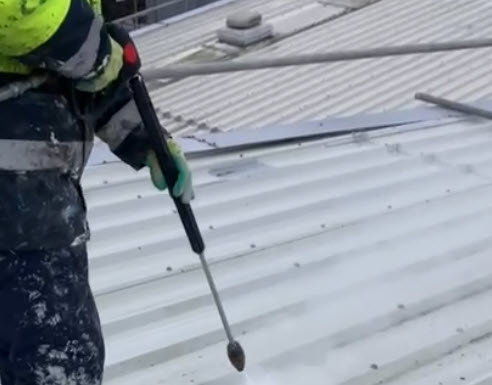Metal Roof Cleaning Recommendations
Before coating a metal roof, it is important that the surface is clean and free from all contaminants. The most commonly used method for cleaning industrial sized roofs is jet washing, because it’s relatively cheap and can usually be completed quite quickly.
Assuming that any existing finishes such as Plastisol are in good condition and firmly adhered to the roof substrate, cleaning should be quite a simple process.
A 3000 – 6000psi powered jet wash equipped with a turbo lance is often the best choice, since this will remove all soiling and fungal growth. The swirling action of the turbo lance attacks the surface and removes even stubborn staining.
During cleaning, the lance should be held so that the spinning water head is just 2-3 inches away from the surface of the metal roof. The further away the lance is from the surface, the less effective the cleaning.
Care should be taken to direct the water down the roof slope and avoid, as far as possible, directing the jets into any openings, such as horizontal roof sheet joints that might be present.
It’s also important to avoid directing the jets at GRP roof lights, as they are easily damaged by strong jet washing. Instead, they should be cleaned using a fungicidal wash, rinsed off with water and a soft bristle brush.
Cleaning Metal Roofs With A Delaminating Finish
Sometimes, the jet washing process will begin to strip the original factory applied finish from the metal roof substrate.
If this happens, it is important to remove as much of the existing finish as possible, since it is known to be unstable. Coating over an unstable finish will probably result in the new coating failing as the original finish continues to delaminate beneath the new coating.
Continuing the jet wash process, all exposed edges of the original finish need to be attacked with the jet was held an inch or so from the surface. This will fully remove all unstable finishes.
Any residue of the original finish that remains after cleaning should be examined for signs of lifting or curling edges, a clear indication that the residue remains unstable.
It should also be cross-cut with a sharp blade and tested with a strong adhesive tape to see whether the residue is removed with the tape as it’s removed, or whether it remains adhered to the roof.
Cleaning Large Metal Roofs
Large metal roofs may need to be cleaned more than once prior to coating, simply because of environmental soiling that occurs almost immediately. The longer a cleaned surface is left before it is coated, the more soiled it becomes and the soiling, which can be dust, bird droppings or similar can prevent or severely reduce adhesion of the new coating system. Effectively, dust and other soiling creates a barrier between the new coating and the substrate.


